 Kalliope’s
Comments
(group member since Aug 28, 2018)
Kalliope’s
Comments
(group member since Aug 28, 2018)
Kalliope’s
comments
from the Ovid's Metamorphoses and Further Metamorphoses group.
Showing 21-40 of 610
 As for painting, this is clearly a great story for depicting erotic scenes... which the text, with the imagery of chase and hunt (Hesperia is like a doe while Aesacus is like a hawk - 'she ran from fear, he ran from love'...), certainly calls for.
As for painting, this is clearly a great story for depicting erotic scenes... which the text, with the imagery of chase and hunt (Hesperia is like a doe while Aesacus is like a hawk - 'she ran from fear, he ran from love'...), certainly calls for.There is this painting, in which much of the narrative has been stripped off.
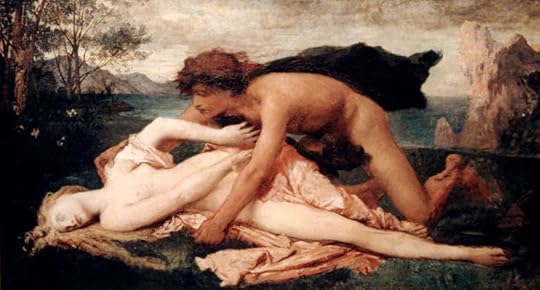
Jules-Élie Delaunay. 1859. Ny Carlsberg Glyptotek, Copenhagen.
It is the first time I hear of this Delaunay.
For a change, here is a piece of ceramics.
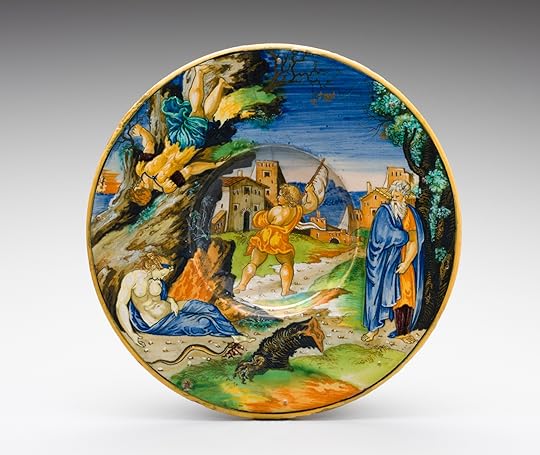
 Peter wrote: "The ornithologist in me feels obligated to add a comment for the last story in Book XI. Thetis transfigures the falling Aesacus into a bird called mergus (XI, 753) in the Latin text, merganser in E..."
Peter wrote: "The ornithologist in me feels obligated to add a comment for the last story in Book XI. Thetis transfigures the falling Aesacus into a bird called mergus (XI, 753) in the Latin text, merganser in E..."Peter, my edition calls this bird 'Diver', and then looking this up, it is also called 'Loon'.
https://en.wikipedia.org/wiki/Loon
But I am very ignorant of birds - a shame for me.
 I have now read the last story, that of Aesacus and Hesperia.
I have now read the last story, that of Aesacus and Hesperia.As RC says, this seems an echo of Eurydice who was bitten by a snake. Has there been another similar episode before?
I was amused by the 'nonchalant' way in which Ovid transitions to this story - there was an old man.. and then somebody around (or was it the same?).. who proceeded to tell the origins of the flying bird.
 Given that we have discussed /looked at both Caravaggio and Bernini... On October 15th, in Vienna, at the KHM starts what looks like a wonderful exhibition on both of them.
Given that we have discussed /looked at both Caravaggio and Bernini... On October 15th, in Vienna, at the KHM starts what looks like a wonderful exhibition on both of them.https://caravaggio-bernini.khm.at/en/
 Scarlet wrote: "Yes I am impatient to read the whole book, the whole Metamorphosis I amthinking about Book 2 and the Deluge and the throwing of the stones the man from the arc who with his wife were injoined by th..."
Scarlet wrote: "Yes I am impatient to read the whole book, the whole Metamorphosis I amthinking about Book 2 and the Deluge and the throwing of the stones the man from the arc who with his wife were injoined by th..."This is a book to keep coming back to.
 Roman Clodia wrote: "
Roman Clodia wrote: "One common way of seeing the movement of the poem is from the age of gods, to the age of heroes, to..."
Yes, that's right... My edition has mentioned this structure too... I hope he keeps the 'quirky' aspects when dealing with the age of men...
 I only have the very last episode to finish Book 11. I may finish it later today and can start with 12 this weekend.
I only have the very last episode to finish Book 11. I may finish it later today and can start with 12 this weekend.
 From my notes.
From my notes.This is the second longest episode after the myth of Phaeton (one of my favourites too).
It has four parts: 1. the departure of Ceyx. - 2. the storm. - 3. Alcyone's dream. - 4 the return of Ceyx and the metamorphosis os both him and Alcyone. And as often is the case, there is a symmetrical arrangement with the departure being balanced by the return.
For almost half of the storm section there is nothing but waves, winds and sky. Ovid uses similes from warfare when describing the storm.
Alcyone prays to Juno because she is the goddess of marriage. The reason why she gets so antsy with Alcyone's presence is that (apart from being always displeased, Alcyone is in mourning but as the funeral rites have not yet been performed her touch pollutes the altar.
On Morpheus - from the Greek morphe - which means 'form'. Morphe is part of the word 'metamorphosis'. Morpheus is then metamorphosis personified.
We have seen so many metamorphosis already that we have noted that they vary a great deal in the length of time (or lines in the poem) they require to take effect. This one is very gradual.
Curious that the gods are not very present - apart from Juno and his envoy....
 Searching paintings I have not been very impressed.
Searching paintings I have not been very impressed.This is what I found.
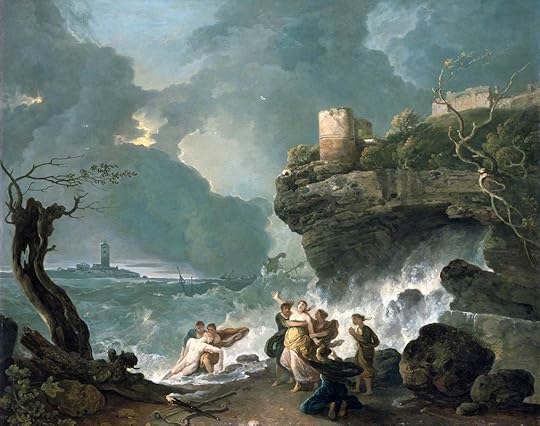
Richard Wilson. Ceyx & Alcyon. 1768. National Museum of Wales.
And this more erotic and rather peculiar painting.

Herbert James Draper. 1915.
And one which I am not sure how authentic it is.
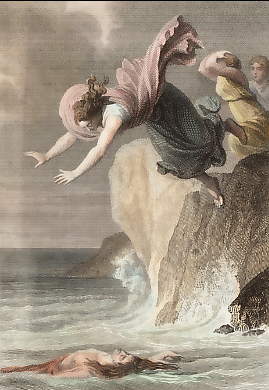
After Moreau le Jeune. 1860.
 So I have now read the everyone's favourite Ceix and Alcyone.
So I have now read the everyone's favourite Ceix and Alcyone.It reminded me of some sections of Moby Dick..!!!
Anyway, I thought that a musical work must have been produced, and I found the opera by Marin Marais from 1706. It was 'tragedie en mystique' and was first represented in the Théâtre du Palais Royal.
Here is the only recorded production, by Jordi Savall, if anyone is interested.
https://www.youtube.com/watch?v=YhkZp...
 Sorry, yes, I found one on the death of Chione. I've never seen this before.
Sorry, yes, I found one on the death of Chione. I've never seen this before.With her twins.

Nicolas Poussin. Death of Chione. 1622. Museum of Fine Arts of Lyon.
The foreshortened Diana seen from behind is very striking... and a bit untypical in Poussin - somewhat Mannerist. I like it.
And below an engraving with a more predictable composition for the arrow scene but with a very interesting scene in the back - it shows the two gods approaching her while she is asleep.

Antonio Tempesta.1606. Metropolitan Museum, NY.
 On to the Alcyone story that has captivate all of you.
On to the Alcyone story that has captivate all of you. I could not find specific images for the above section.
 I have now read the disconcerting section of Pelus arriving in Trachis and meeting Ceyx.
I have now read the disconcerting section of Pelus arriving in Trachis and meeting Ceyx. In my notes it discusses the tripartite nature: 1. Peleus arrival. 2. Story of Dandelion and Chione and 3. the story of the monstrous wolf.
I was taken aback by the sudden transition and the mentioning of Pelus killing his brother Phocus. It seems usually this episode comes before the marriage to Thetis but in this way it allows time for Achiles to grow up.
Then the part with Ceyx and his niece provides several contrasts: one is that Peleus is pretty violent while Ceyx and his kingdom are tranquile. There is a double rape. Peleus tried twice to rape Thetis while two gods, Apollo and Mercury rape Chione. In both the woman is sleeping but one was already sleeping with the other has been induced into it.
Then I was (again!) surprised with what follows after the rape and the birth of those 'twins', because one feels sorry for Chione, but then she reacts with pride and brags, and of course, she is punished by Diana. And how?... in a familiar way in the MET - by losing her ability to speak - but not through metarmorphosis but through an arrow - followed by death.
The one who transforms is her sorrowful father - again most peculiar for he becomes a hawk 'friend to no bird, savage toward them all'... not an attractive bird.
So now Peleus is going to be punished by Phocus mother by attacking through the monster his herds... Interesting that going on exile Peleus takes his sheep along...
Sorry for making this kind of little summary, but I am trying to understand the transitions.
 Peter wrote: "The ornithologist in me feels obligated to add a comment for the last story in Book XI. Thetis transfigures the falling Aesacus into a bird called mergus (XI, 753) in the Latin text, merganser in E..."
Peter wrote: "The ornithologist in me feels obligated to add a comment for the last story in Book XI. Thetis transfigures the falling Aesacus into a bird called mergus (XI, 753) in the Latin text, merganser in E..."Peter, you must be really enjoying reading the MET, with so many birds cropping up everywhere.
 Roman Clodia wrote: "That Ingres painting is amazing - and weird! Thanks Kalli, you give us so many images that I've never seen before.
Roman Clodia wrote: "That Ingres painting is amazing - and weird! Thanks Kalli, you give us so many images that I've never seen before. As you're catching up rapidly, maybe we should pause on Book 13 till you've reac..."
Yes, the Ingres painting is VERY peculiar. I first saw it at an early age and since then every time Thetis is mentioned I think of that image...
Thank you all, very considerate about your pausing in Bk 13.
I hope to finish 11 and start 12 by the end of the week so hopefully I will reach the point at which you are by next week.
 My notes say that it was traditionally Themis who warned Zeus to stay away from Thetis. Ovid, by having Proteus being the one to warn the god, seems to be inventing something.
My notes say that it was traditionally Themis who warned Zeus to stay away from Thetis. Ovid, by having Proteus being the one to warn the god, seems to be inventing something.
 I have now read the section of the foundation of Troy and Laomedon and Peleus and Thetis.
I have now read the section of the foundation of Troy and Laomedon and Peleus and Thetis. I was taken aback to see Hercules back... after his apotheosis, but then, time is elastic or circular here...
Encountering Thetis, Ingres very peculiar painting came to my mind.
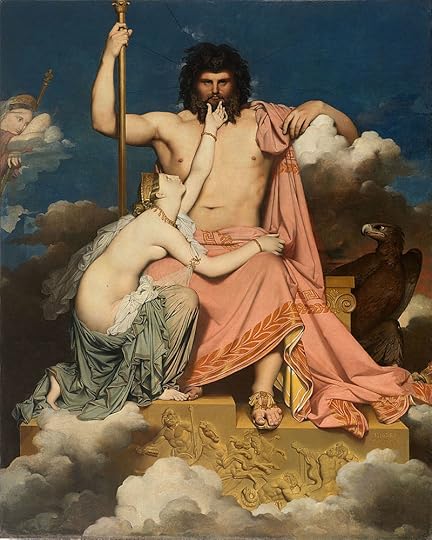
Dominque Ingres. Jupiter and Thetis. 1811. Musée Granet.
But I also looked around for Thetis and the dolphin. I had never associated her with this mammal. I could only find it in classical vases... A shame that Raphael did not paint her with the animals as he had done with Galatea.

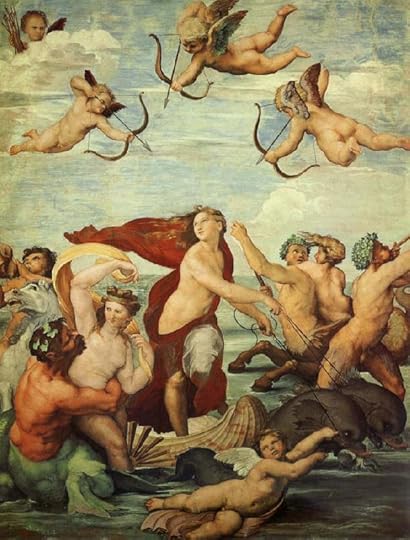
 Roman Clodia wrote: "On the other hand, in death Orpheus is reunited with Eurydice: 'he found the wife he had lost and held her close in his arms'. Is he happier in death than in life? Striking that there's no mention of him singing in the underworld after he dies..."
Roman Clodia wrote: "On the other hand, in death Orpheus is reunited with Eurydice: 'he found the wife he had lost and held her close in his arms'. Is he happier in death than in life? Striking that there's no mention of him singing in the underworld after he dies..."There is critic (Segal) who wondered if there was a reason for Ovid for 'giving the most famous of all poets nothing too say at this great moment (reunification with Eurydice)?
The editor of my edition thinks that this may be due to Ovid's rhetorical skills - the importance of gestures over words at times.
 There is this great painting of disappointed women.. Not really Ovidian - they are related to another episode, a historical one, but they came up in my search for images. They are comical.
There is this great painting of disappointed women.. Not really Ovidian - they are related to another episode, a historical one, but they came up in my search for images. They are comical.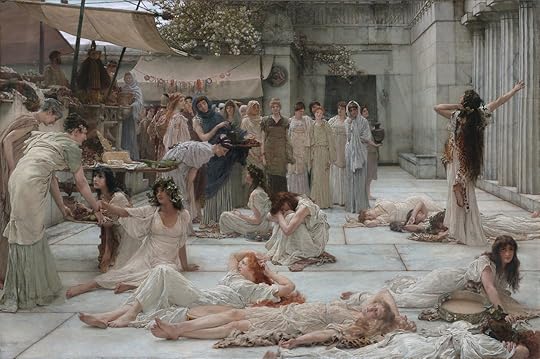
Alma-Tadema. Women of Amphissa. 1887. Clark Art Institute.
 I was amused to read about King Midas and Sardis and Lydia. An archaeologist friend of mine has been excavating there. That's where metal coins first began to be used.
I was amused to read about King Midas and Sardis and Lydia. An archaeologist friend of mine has been excavating there. That's where metal coins first began to be used.And I always associate Gluck's Orpheus with Crete. I remember listening to the music in a shop in Heraklion and I just kept looking at the things exposed because they were playing this music in the shop and I wanted to continue listening to it...

